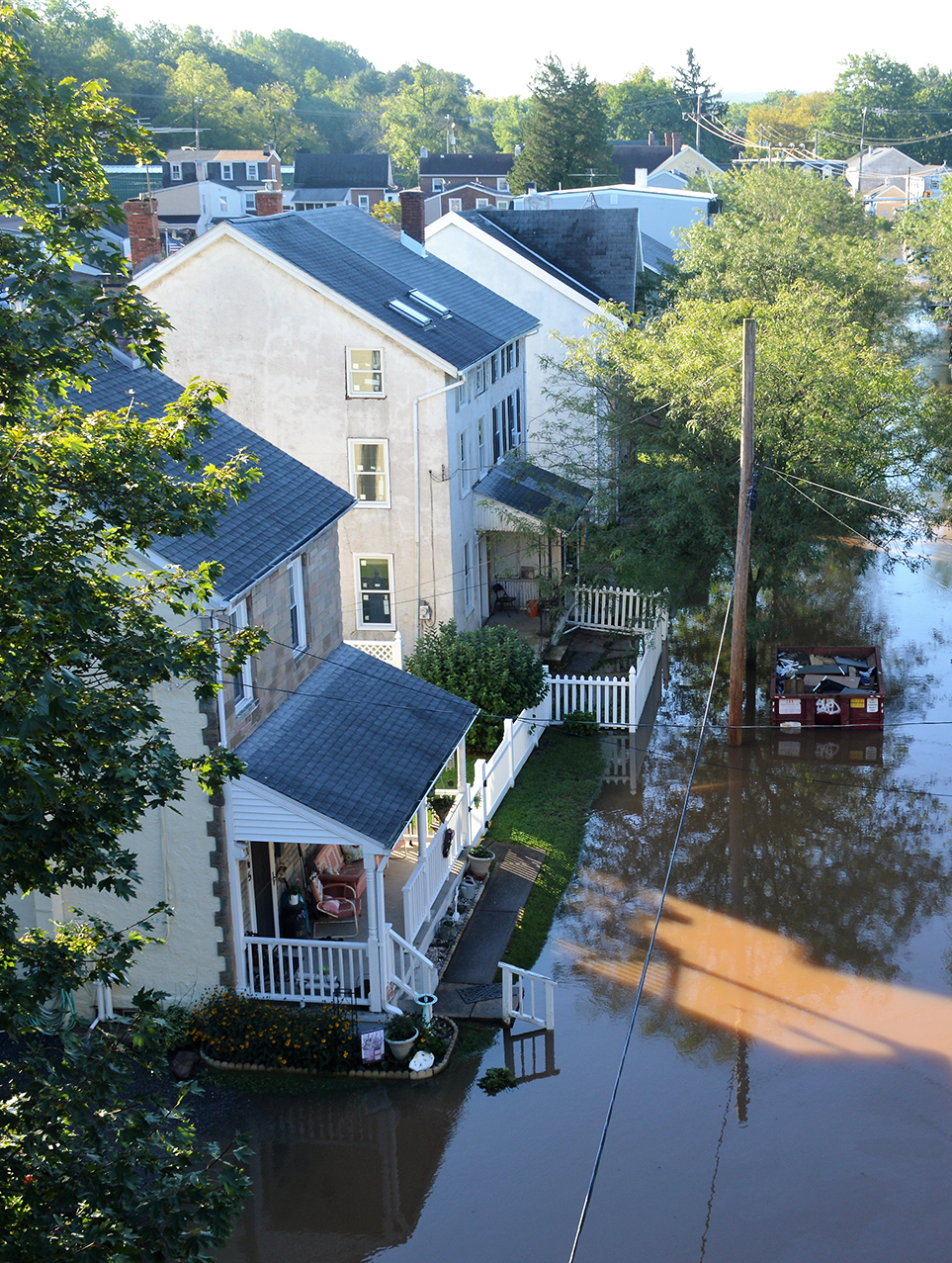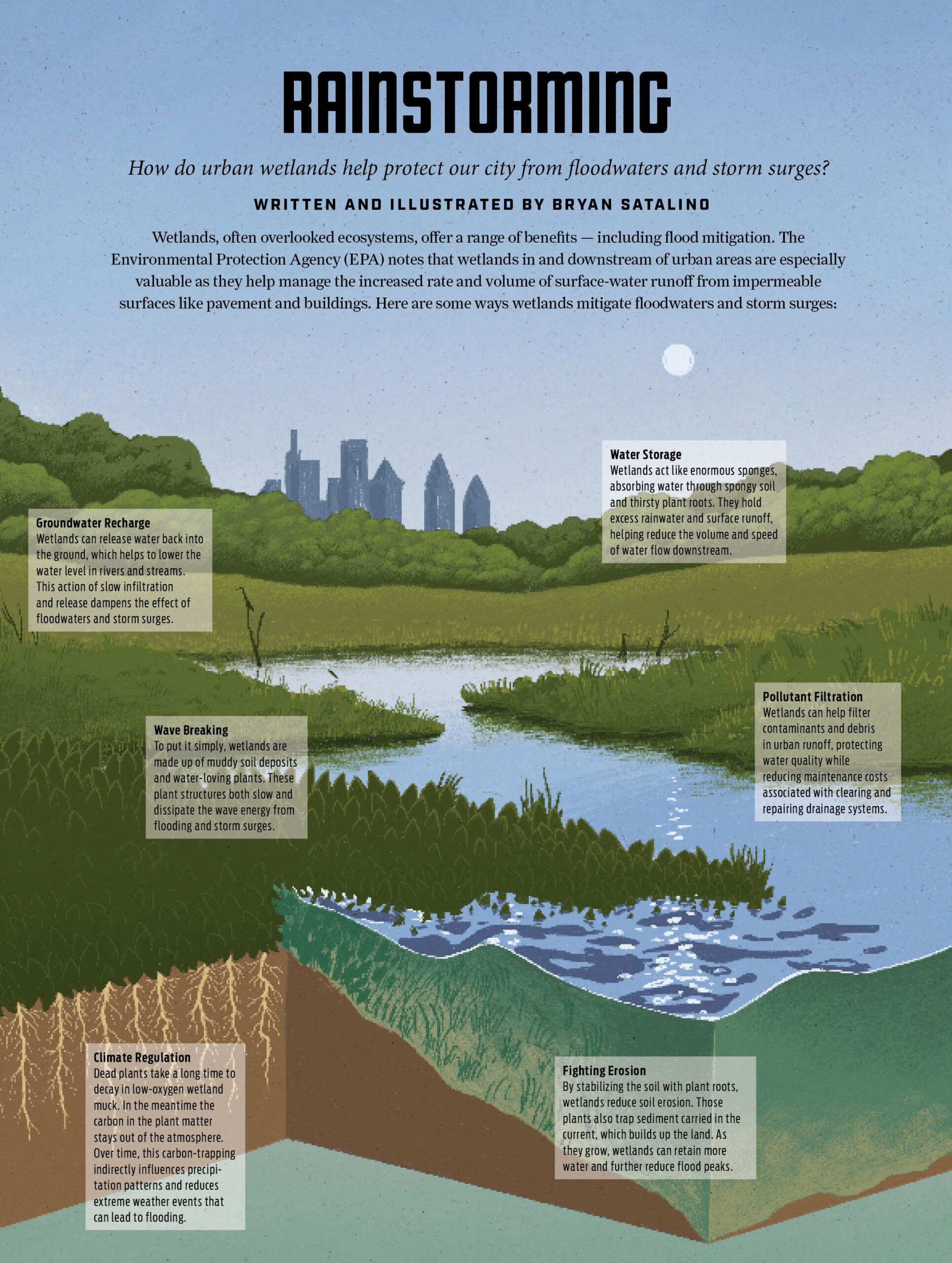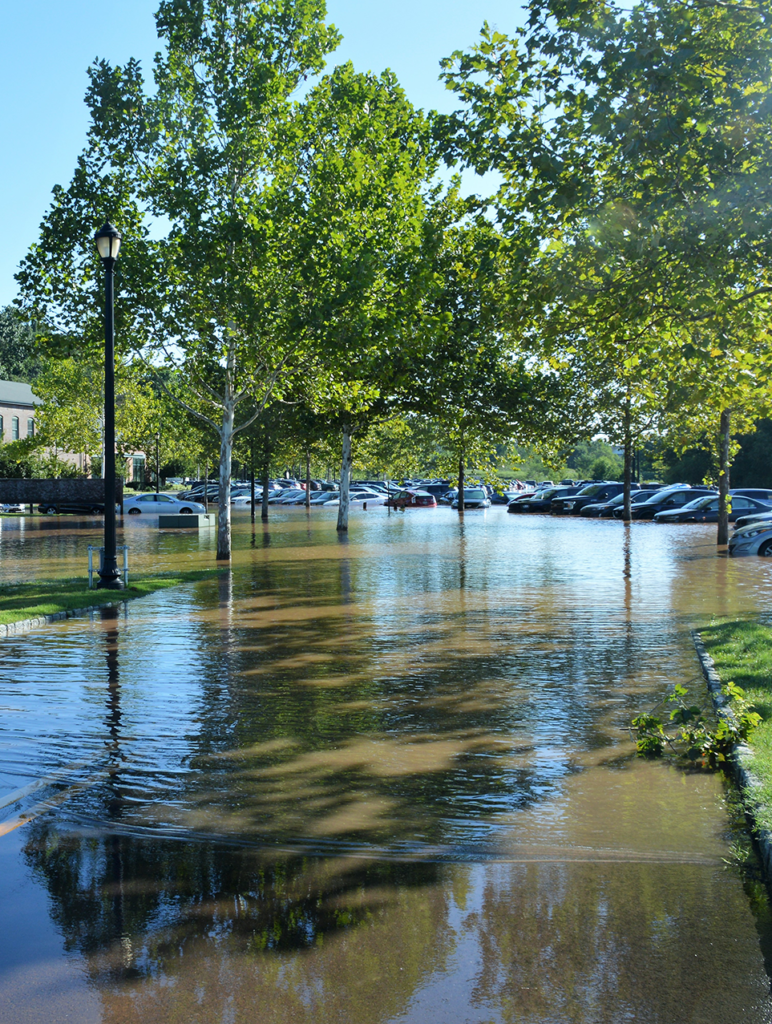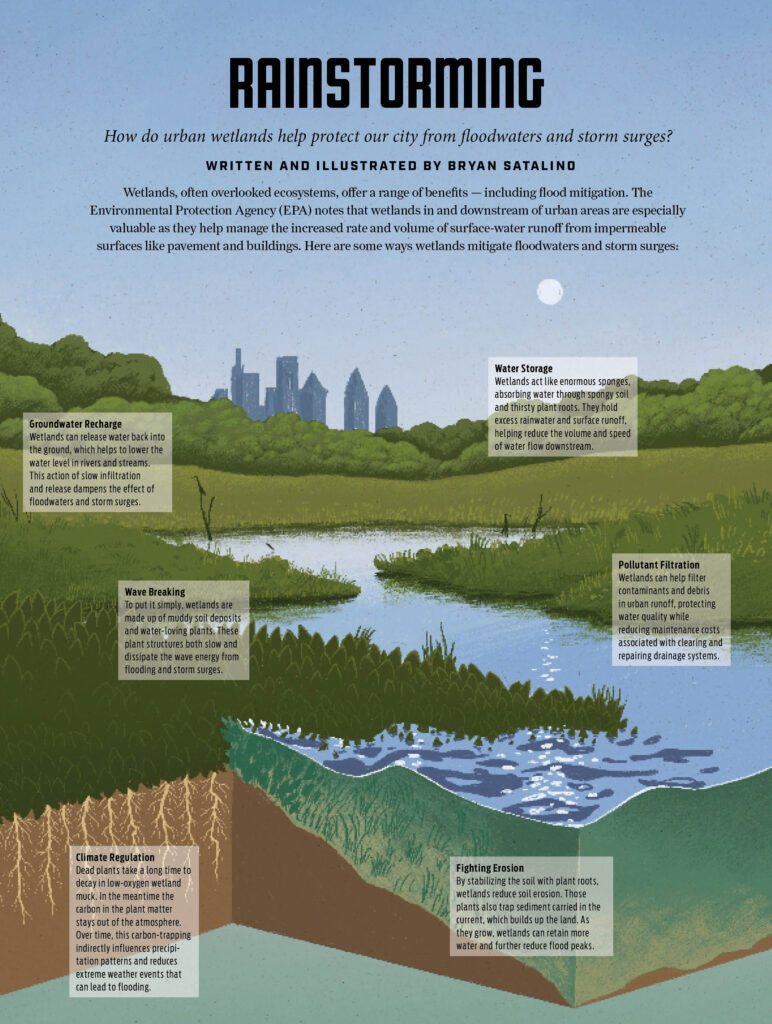During his third year in office as a Pennsylvania State Representative, Joe Webster found a menace hiding within his bucolic Montgomery County district. Snaking its way through the landscape, lurking beneath bridges near the downtowns of Schwenksville, Graterford and Collegeville, the Perkiomen Creek was lying in wait.
When the remnants of Hurricane Ida arrived in September 2021, the typically peaceful creek erupted. At a U.S. Geological Survey water gauge at Graterford, flood stage officially begins at 11 feet, and the device can measure waters as high as 24 feet. But the creek rose off the charts, with eventual estimates topping out at a record 26.5 feet.
When the waters subsided, destruction emerged. Across the Perkiomen watershed, 75 homes were destroyed, uncounted businesses suffered damages and two residents had died. Statewide, estimates of the storm’s cost eclipsed $100 million.
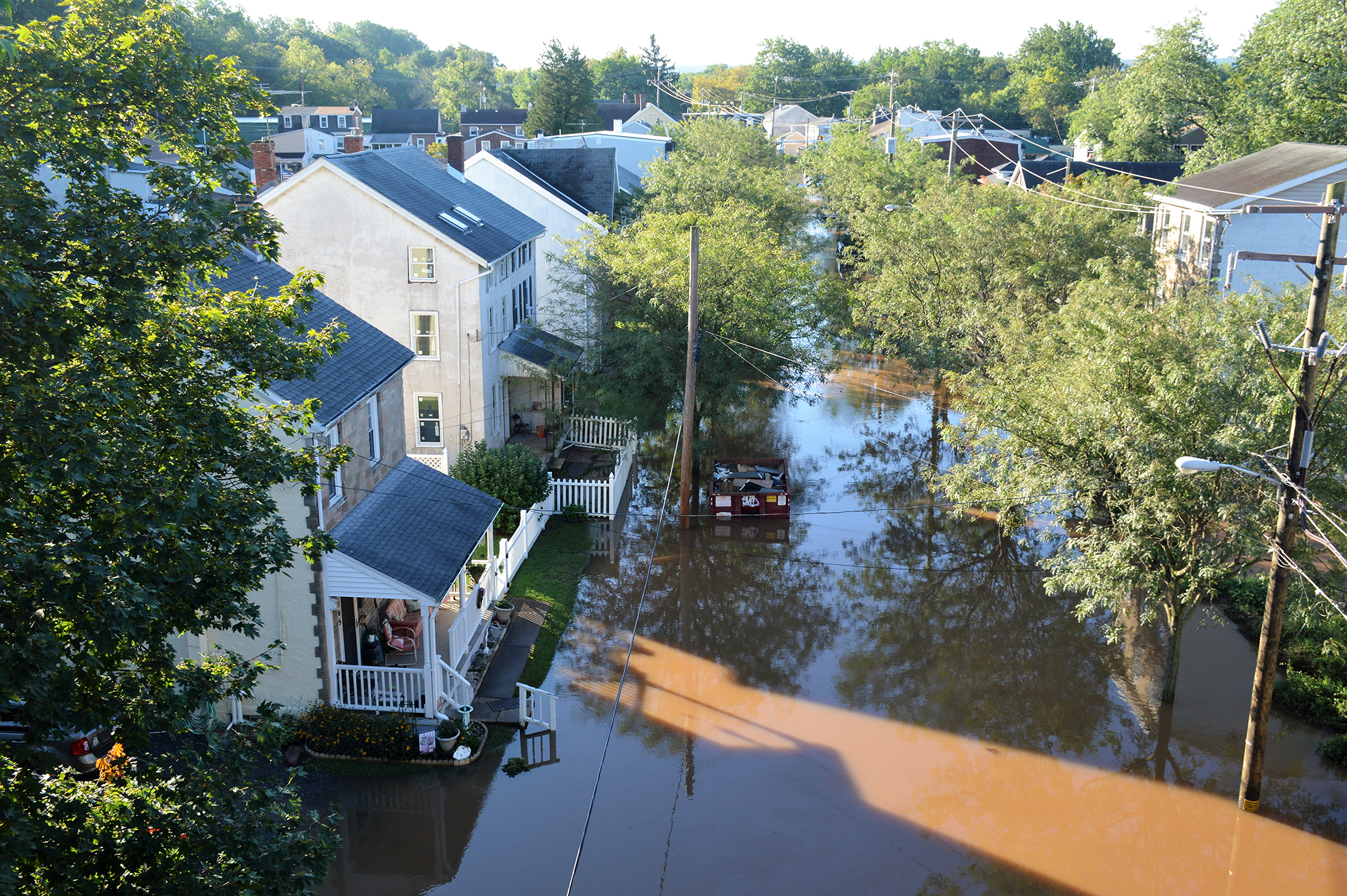
“It was a devastating flood, and obviously one of the reasons why my staff and I have been interested in a number of policy actions around watershed flooding,” Rep. Webster says.
His district and its creekfront towns sit near the bottom of the 362-square-mile Perkiomen watershed, which spans 55 municipalities across four counties. Trying to solve the problem locally came with obvious limitations; Rep. Webster determined he needed upstream buy-in to move the needle on reducing flooding from future storms.
But three years later, his efforts illuminate the seemingly intractable problem of winning support for regional floodplain management anywhere in Pennsylvania.
At the State House, Rep. Webster re-introduced H.B. 1275, a decade-old piece of legislation he inherited that would overhaul protections for riparian buffers, strips of vegetation that can slow the entry of heavy rains into waterways and mitigate flood damages. According to Maya van Rossum, the Delaware Riverkeeper, the bill is one of the most important for flood mitigation in Pennsylvania at a watershed scale.
Pennsylvania has been unable to deal with not only [flooding], and what’s happening in the environment, but second, the cumulative effects of development.”
— Joe Webster, PA State Representative, Montgomery County
Over the decades, development has exacerbated flooding along the Delaware and its myriad tributaries, including the Perkiomen. Combined with climate change’s extreme rainfall, one 2020 study estimated the twin dynamics could increase flooding discharge in the watershed up to 66% by century’s end.
Despite this increasingly grim reality, van Rossum says there have been strikingly few large-scale initiatives to address the issue. Following a series of devastating floods that struck Delaware River towns in Bucks County in the 2000s (which also impacted flood-prone Philadelphia neighborhoods such as Manayunk), van Rossum joined the Interstate Flood Mitigation Task Force, created by the Delaware River Basin Commission (DRBC), a joint state-federal entity overseeing the watershed. In 2007 the task force released a 151-page report with a series of recommendations. Some, such as a flood warning system, were implemented, van Rossum says.
But she adds that the most “substantive” sections of the report — including a wishlist of recommended policy changes, such as buyouts for flood-prone properties and mandatory flood disclosure requirements for real estate transactions — have since “sat on the shelf.” For its part, a DRBC spokesperson said the effort “primarily” guided flood mitigation efforts at the local and state levels, and that the commission has focused on developing “tools and information” for localities.
“With increased understanding of the effects of climate change on hydrology, best available science and current best practices for floodplain management have evolved since the 1970s, when the DRBC Floodplain Regulations (FPR) were adopted,” spokesperson Elizabeth Koniers Brown wrote in an email. “As resources become available, the FPR are expected to undergo revision based upon the best available science.”
Repairing the riparian
One key policy change recommended by the 2007 report was to better protect the watershed’s riparian buffers, which is why Rep. Webster’s H.B. 1275 caught van Rossum’s eye more than 16 years later. Webster says that after Democrats took control of the House for the first time in more than a decade in 2022 — just a year after Ida — he sensed an opening. Webster sits on the House Environmental Resources and Energy Committee, and after a decade in minority-party purgatory, committee chair Rep. Greg Vitali (D-Delaware County) gave the bill a hearing in October 2023. The Riverkeepers supported it, as did an interesting coalition of rod-and-gun groups who like riparian buffers for their boosting of game habitat, Webster says.
Real estate industry groups opposed the bill for what they warned would be dramatic restrictions on development. But those familiar with the politics say it was opposition from the Pennsylvania Department of Environmental Protection (DEP) that has left the bill in committee limbo. In an email to Grid, Rep. Vitali shared a list of six issues that the DEP took with the bill, most of which suggested conflicts with other state codes, which Rep. Vitali framed as “technical and not political” opposition.
In an email, the DEP did not directly respond to a question from Grid regarding its apparent opposition. However, DEP press secretary Neil Shader listed a number of initiatives he says the DEP has undertaken, including a flood protection program that since 1946 has installed more than 200 projects across the state, such as concrete channels, floodwalls and levees; as well as floodplain restoration efforts funded through the state’s Growing Greener grants program.
Rep. Webster doesn’t believe that improving floodplain management is a priority for the state. The third-term lawmaker says his quest for solutions to flooding in his district coincided with his education on the political winds that have long blown in the halls of power in Harrisburg. After he was first elected in 2018, Webster recalls entering the State Capitol building and examining the ornamentation decorating the lofty rotunda, where murals and stained glass windows spell out the state’s civic virtues.
“Liberty and justice and education,” Rep. Webster observed. “And oil and gas and coal.”
Rep. Webster notes the DEP has been stripped of hundreds of staff members over the past several decades, a period of time in which Republicans have controlled most levers of power in Harrisburg. He believes the defunding has left the department with a kind of “post-traumatic stress disorder” that causes it to recoil from major changes.
“I would say their reaction to the bill was, ‘I should have 20 people in my department. I have six and you’re giving me more work to do,’” Rep. Webster says. “I’m compassionate about that … but if that’s the case, tell us you need more people in your organization … don’t say we don’t believe in environmental laws.”
Between a bay and a hardscape
Abby Sullivan, chief resilience officer for Philadelphia’s Office of Sustainability, knows how helpful a regional approach is to mitigating flooding in the city. She notes Philadelphia is not only situated toward the bottom of a Delaware River watershed that has become ever-more developed, but is also subject to tidal action from the south. So hardscapes in either direction can exacerbate flooding here.
And while the city’s complex political machinery can create internal conflict about which flood mitigation efforts it should pursue (look no further than Eastwick) Sullivan says there doesn’t appear to be much on the policy menu for trying to coordinate with entities outside of city limits.
We could do everything in our power in the city to protect, but if everybody upstream is doing practices that make flooding worse, it’s a really big challenge.”
— Abby Sullivan, Philadelphia Office of Sustainability
“We could do everything in our power in the city to protect, but if everybody upstream is doing practices that make flooding worse, it’s a really big challenge,” Sullivan says, adding that she’s “not aware of an entity that’s proactively planning for flooding at a regional scale.”
Rep. Webster says the challenge in tackling regional-level flooding starts with the fractious nature of Pennsylvania’s political system. According to Governing.com, Pennsylvania has 2,625 county and local governments, third most of any state. Each one is given significant local authority to set zoning codes, and the state’s conservative past has also bent toward the rights of property owners.
“We have a problem where Pennsylvania has been unable to deal with not only [flooding], and what’s happening in the environment, but second, the cumulative effects of development,” Rep. Webster says.
Josh Lippert, a professional floodplain manager and former chair of Philadelphia’s Flood Risk Management Task Force, says the matter is even further complicated by policies that prohibit staff at many municipalities from engaging in lobbying work. When he previously worked for the City of Pittsburgh, he and colleagues could at least work with Allegheny County, which contains both Pittsburgh and its surrounding townships. But in Philadelphia, he says, there aren’t many options in the toolbox for program staff to make their case to powerbrokers outside the city, leaving it in the hands of politicians, who may or may not be interested in doing so.
“There really aren’t those mechanisms within the City government to do that type of lobbying work,” Lippert says. “It’s a conundrum.”
Still, the landscape isn’t completely devoid of entities in position to make a difference. Many point to the DRBC as perhaps the most obvious political body. As the commission is controlled by the governors of Pennsylvania, New York, New Jersey and Delaware, as well as a representative from the federal government, regulatory changes like those laid out in the 2007 report are heavy political lifts. But spokesperson Koniers Brown says the agency partnered with New Jersey state agencies in 2008 to develop a “multi-jurisdictional flood mitigation plan” for 43 municipalities there.
“This initiative helped participating communities become more disaster resistant by identifying measures for reducing their long-term risks from flooding and enabling them to better compete for FEMA funding aimed at flood mitigation,” Koniers Brown said.
State governments indeed have the authority to enact change for their portions of the watershed. Lippert notes that in 1978, Pennsylvania lawmakers actually passed a bill that required municipalities statewide to participate in the National Flood Insurance Program, a federal initiative that requires local governments to adopt minimum standards for floodplain management in exchange for the ability to secure federally-backed flood insurance for residents.
Some also point to the Delaware Valley Regional Planning Commission, a federally-designated Metropolitan Planning Organization, which has done some work around flooding. Lippert in particular notes the commission developed a climate model to help local governments understand the effects of climate change and sea level rise. But once again, without the force of law, he says its impact is limited.
“It’s a great interactive map but it’s not used to do actual, built environment decision making,” Lippert says. “It’s largely sat on the shelf.”

A deep state to stop deep floods?
Despite the lack of a comprehensive effort to address watershed-wide flooding, many are finding some solace in a surprising group of people: the next generation of bureaucrats and engineers. From this perspective, things feel like they’re moving in the right direction, with innovative thinkers currently developing the foundations on which future floodplain practitioners can build something better.
Lisa Auermuller is administrative director of the Megalopolitan Coastal Transformation Hub (MACH), a collection of 13 institutions headquartered at Rutgers University, propelled by a $20 million National Science Foundation grant to study flood resiliency from New York City to Philadelphia. She says MACH operates as a kind of free research and development lab for municipal governments, consulting with professionals like Sullivan to answer critical hyperlocal questions; the lab even keeps in its arsenal a van equipped with lasers to drive around cities and create detailed floodplain maps. But MACH can also help with softer sciences, such as finding social inequities in a community that can aid applications for grant money for flood resilience, which is particularly beneficial for smaller municipalities without a wealth of professional staff.
While such efforts don’t do much to solve a watershed-wide collective action problem in the near term, Auermiller says interactions between students and scientists working under MACH and government officials like Sullivan could pay major dividends in the future. Clinton Andews, a professor of urban planning at Rutgers and MACH member, adds that he believes their experiences will eventually even lead to regulatory changes.
“You get all these scientists and engineers to think about reforming professional practices … the knowledge base that the planners and municipal engineers and the accounts use,” Andrews says. “That’s how you get change institutionalized. It’s not just by trying to lobby government, or persuading individual households.”
Rep. Webster is pushing for similar innovation with Pennsylvania’s political machinery. While he continues to work to pass H.B. 1275 (which would face a potentially impossible hill to climb in the Republican-controlled State Senate), the representative is also spearheading “The Perkiomen Project,” a voluntary effort to bring together county and municipal officials, along with institutions like universities and chambers of commerce, to seek watershed-wide flooding solutions. Most notably, Webster says the project has obtained money to do advanced mapping of the Perkiomen watershed. Ultimately, he hopes it will identify areas where infrastructure can be improved to reduce flooding. Then, he can seek more funding and political support to make it happen.
“If it turns out that, 100 miles west of something, that’s where a project should be built … then it’s my job to bring [that community] money, bring resources,” Rep. Webster says. “We’re not trying to build a mandate where we tell some small municipality they have a $30 million problem.”
Under this system, solutions could get creative. Instead of paying $10 million to build a levee that protects one downstream community but floods another, the money could be spent upstream preventing too much water from getting there in the first place. Lippert, who counts himself among the forward-thinking practitioners, says such creative efforts might just become the laws of the future.
“Once you prove the concept, then maybe adopt the [regulations] to make this a more statewide initiative,” Lippert says.
 This content is a part of Every Voice, Every Vote, a collaborative project managed by The Lenfest Institute for Journalism. Lead support for Every Voice, Every Vote in 2024 and 2025 is provided by the William Penn Foundation with additional funding from The Lenfest Institute for Journalism, Comcast NBC Universal, The John S. and James L. Knight Foundation, Henry L. Kimelman Family Foundation, Judy and Peter Leone, Arctos Foundation, Wyncote Foundation, 25th Century Foundation, and Dolfinger-McMahon Foundation. To learn more about the project and view a full list of supporters, visit www.everyvoice-everyvote.org. Editorial content is created independently of the project’s donors.
This content is a part of Every Voice, Every Vote, a collaborative project managed by The Lenfest Institute for Journalism. Lead support for Every Voice, Every Vote in 2024 and 2025 is provided by the William Penn Foundation with additional funding from The Lenfest Institute for Journalism, Comcast NBC Universal, The John S. and James L. Knight Foundation, Henry L. Kimelman Family Foundation, Judy and Peter Leone, Arctos Foundation, Wyncote Foundation, 25th Century Foundation, and Dolfinger-McMahon Foundation. To learn more about the project and view a full list of supporters, visit www.everyvoice-everyvote.org. Editorial content is created independently of the project’s donors.


